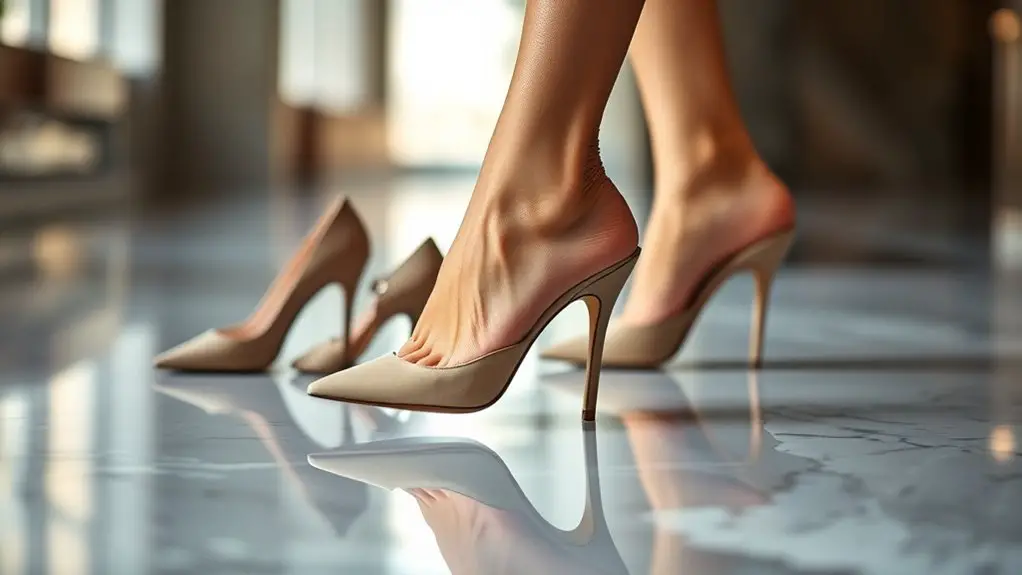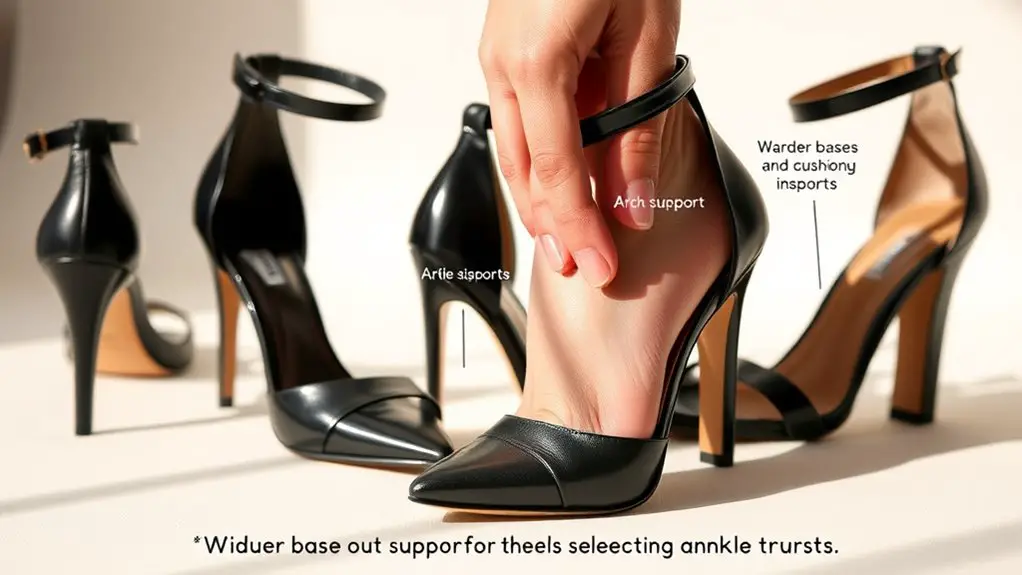To avoid twisting your ankle in heels, choose lower styles with wider bases for stability. Ascertain a proper fit, allowing toe movement without cramping, and pay attention to heel height based on your comfort. Select supportive designs, like chunky heels or those with ankle straps. Practice proper walking techniques, maintain good posture, and take breaks to reduce fatigue. Strengthen your ankles with exercises and utilize anti-slip products for added support. Your next steps can provide even more insights.
Understanding Heel Heights

When you’re maneuvering the world of high heels, understanding heel heights is essential, especially if you want to avoid ankle twists. Heel height considerably impacts your foot alignment and overall heel balance. Low heels, typically under two inches, provide more stability, making them a safer choice for beginners or those who aren’t used to higher styles.
Mid-height heels, ranging from two to four inches, require a bit more skill in maintaining proper foot alignment to prevent strain. Finally, high heels above four inches can dramatically alter your center of gravity, increasing the risk of twisting your ankle if you’re not accustomed to them.
To navigate these various heights safely, practice walking in different heels on even surfaces first. This helps you gauge how each height affects your balance and foot alignment, enabling you to choose wisely and reduce the risk of injury.
Choosing the Right Fit
Although you may be tempted to choose heels based solely on their aesthetic appeal, selecting the right fit is vital for preventing ankle injuries. To guarantee a comfortable fit, pay attention to shoe dimensions, including width and length. A shoe that’s too tight can lead to instability, while one that’s too loose increases the risk of slipping.
Make certain the toe box provides enough space for your toes to move without cramping. A cramped toe box can cause discomfort and affect your balance, making it easier to twist your ankle. When trying on heels, walk around to assess how they feel; you should have a snug fit without excessive pressure.
Selecting the right fit doesn’t just enhance comfort—it’s a significant step in guaranteeing your safety while wearing heels. Prioritize fit over fashion to enjoy your heels without the risk of injury.
Selecting Supportive Styles

When selecting heels, it’s crucial to prioritize styles that offer better support. Choose chunky heels for added stability, opt for ankle straps to secure your feet, and look for cushioned soles to enhance comfort. These features can greatly reduce your risk of twisting an ankle while still allowing you to enjoy fashionable footwear.
Choose Chunky Heels
Choosing chunky heels can considerably reduce your risk of twisting an ankle, as their wider base provides better stability and support. Beyond safety, chunky heels offer several benefits that make them a smart choice for any occasion. Here are some chunky heel benefits and reasons for their style versatility:
- Enhanced balance: The broader base helps distribute your weight evenly.
- Comfort: Chunky heels often feature cushioned insoles for added comfort during wear.
- Fashion-forward: They come in various styles, from boots to sandals, making them perfect for any outfit.
- Durability: Chunky heels are typically sturdier, reducing wear and tear over time.
Incorporating chunky heels into your wardrobe can keep you stylish while minimizing injury risk.
Opt for Ankle Straps
In addition to opting for chunky heels, incorporating ankle straps into your footwear choices can considerably enhance stability and support. Ankle straps provide essential security by wrapping around your ankle, helping to prevent slips and twists. This added support is particularly beneficial when traversing uneven surfaces or spending long hours on your feet. Furthermore, ankle strap benefits extend beyond functionality; they also offer impressive style versatility. Whether you’re dressing up for a formal event or keeping it casual, ankle strap heels can complement a variety of outfits. From strappy sandals to elegant pumps, choosing styles with ankle straps can elevate your look while keeping your ankles secure. So, when shopping for heels, don’t underestimate the value of ankle straps.
Look for Cushioned Soles
While many may prioritize style over comfort when selecting heels, looking for cushioned soles is vital for maintaining foot health and stability. Cushioned soles equipped with advanced cushion technology help absorb shock and reduce pressure on your feet, making them imperative for extended wear. Here are some factors to take into account:
- Material Composition: Look for soles made from flexible, durable materials.
- Arch Support: Verify the cushion provides adequate arch support for better alignment.
- Thickness: A thicker sole often offers more cushioning and impact protection.
- Insole Design: Opt for heels with removable insoles for customizable comfort.
Practicing Proper Walking Techniques

When it comes to walking in heels, considering heel height is essential for maintaining balance and stability. You’ll also want to be mindful of your foot placement to avoid missteps that could lead to injury. Practicing these techniques can greatly reduce your risk of twisting an ankle.
Heel Height Consideration
Choosing the right heel height is essential for maintaining stability and preventing ankle injuries. While higher heels can enhance your posture and add elegance, they also come with risks. Understanding the heel height benefits and drawbacks can help you make informed choices.
- Benefits:
- Elevates your appearance, making legs look longer.
- Can improve your confidence and posture.
- Drawbacks:
- Increases the risk of ankle twists and falls.
- Can cause discomfort and fatigue over time.
Consider your comfort level and the occasions you’ll be wearing heels. If you’re not accustomed to higher heels, start with a moderate height to build your confidence and reduce the likelihood of injury.
Foot Placement Awareness
How can you guarantee your foot placement is ideal when walking in heels? Developing foot awareness is essential for maintaining balance and preventing ankle injuries. Start by practicing placement strategies; keep your feet aligned with your hips and avoid stepping too wide or narrow. This will enhance stability. When walking, always place the heel down first, followed by the toe, allowing your weight to shift smoothly. Pay attention to your foot’s position with each step; look ahead rather than down. Visualize a straight line as your path and follow it closely. Regularly practicing these techniques can help you gain confidence and improve your overall walking posture in heels, reducing the risk of twisting your ankle.
Strengthening Your Ankles
Although wearing heels can elevate your style, strengthening your ankles is essential for preventing injuries and ensuring stability. Incorporating ankle exercises and balance training into your routine can make a significant difference. Here are some effective strategies to help you enhance your ankle strength:
Strengthening your ankles is crucial for stability and injury prevention, especially when wearing heels. Incorporate exercises for better support.
- Calf Raises: Stand on the edge of a step and lift your heels up and down.
- Ankle Circles: While seated, lift one foot and rotate your ankle in circles to improve flexibility.
- Single-Leg Stands: Balance on one leg for 30 seconds to strengthen stabilizing muscles.
- Resistance Band Exercises: Use a resistance band to perform ankle flexion and extension movements.
Navigating Different Surfaces
While maneuvering different surfaces, it’s essential to be aware of how the terrain can impact your stability in heels. Uneven terrains, such as cobblestones or gravel, can increase your risk of twisting your ankle. When stepping on these surfaces, make sure to place your foot flat to maintain balance.
Additionally, consider the surface materials. Hard surfaces like concrete can provide more stability than softer ones like grass, which may shift underfoot. When walking on these varying materials, take shorter, more deliberate steps to enhance your control and reduce the chance of a misstep.
If you know you’ll be traversing tricky surfaces, choose heels with wider bases or lower heights, as they offer better support. Staying mindful of the terrain and adjusting your walking style can greatly help in avoiding ankle injuries while wearing heels.
Utilizing Anti-Slip Products
One effective way to enhance your stability in heels is by utilizing anti-slip products. These items can greatly reduce the risk of twisting your ankle while providing extra grip. Consider incorporating the following options into your shoe routine:
- Anti slip insoles: These can offer additional cushioning and traction, helping to stabilize your foot inside the shoe.
- Grip enhancing sprays: A quick application can improve the surface of your shoes, making them less slippery on various surfaces.
- Rubber sole stickers: Adding these to the bottom of your heels can create a non-slip surface, improving grip.
- Heel grips: These can keep your foot securely in place, reducing the chance of slipping out of your shoe.
Taking Breaks and Alternating Shoes
Taking breaks and alternating shoes can considerably reduce the risk of twisting your ankle while wearing heels. When you’re in heels for extended periods, your feet can become fatigued, increasing the likelihood of missteps. By taking breaks, you allow your feet to rest and recover, which helps maintain your balance and coordination.
Additionally, consider alternating shoes throughout the day. Switching to flats or shoes with lower heels can give your feet a much-needed reprieve. This not only alleviates pressure but also encourages proper foot alignment, reducing the risk of injury.
If you’re attending an event, pack a pair of comfortable shoes to wear during breaks, allowing your feet to relax. Remember, your safety and comfort should come first. By incorporating these practices, you’ll enhance your stability and enjoy wearing heels without the constant fear of twisting your ankle.
Paying Attention to Your Posture
Maintaining proper posture is essential for stability when wearing heels, as it directly influences your balance and foot alignment. Being aware of your posture alignment can greatly reduce the risk of twisting your ankle. Here are some tips to enhance your body awareness while in heels:
Proper posture is crucial for stability in heels, impacting balance and foot alignment while reducing ankle twist risk.
- Keep your shoulders back: This helps distribute your weight evenly and maintains balance.
- Engage your core: A strong core supports your spine and stabilizes your movements.
- Bend your knees slightly: This reduces pressure on your ankles and allows for better shock absorption.
- Align your head over your shoulders: This prevents leaning forward, which can throw off your balance.
Knowing When to Say No to Heels
Knowing when to say no to heels is vital for your safety and comfort. It’s essential to assess the fit and comfort of your shoes, as well as the nature of the event and terrain you’ll be traversing. If the circumstances aren’t right, opting for a more suitable footwear choice can save you from potential injuries.
Assess Comfort and Fit
When it comes to wearing heels, comfort and fit are essential factors that can determine whether your evening is enjoyable or painful. It’s vital to assess how the shoe materials interact with your foot shape before making a purchase. Here are some key points to take into account:
- Try them on: Walk around to see if they pinch or rub.
- Check the arch: Verify it supports your foot’s natural curve.
- Take into account the heel height: Opt for a height you can manage comfortably.
- Look for cushioning: Extra padding can make a significant difference.
Consider Event and Terrain
While attending an event, it’s essential to take into account the terrain and setting before slipping into those stylish heels. Certain event types and terrain conditions can greatly impact your comfort and safety. If you’re headed to a garden party on grassy ground, for instance, heels might not be the best choice.
| Event Type | Recommended Footwear |
|---|---|
| Outdoor Wedding | Flats or Wedges |
| Formal Gala | Heels (if on flat surface) |
| Beach Party | Sandals |
| Concert/Festival | Comfortable Sneakers |
| Business Meeting | Professional Heels |
Frequently Asked Questions
Can Wearing Heels Affect My Overall Foot Health Long-Term?
Wearing heels can considerably impact your overall foot health long-term. It affects ankle alignment and can weaken foot arches, leading to discomfort and potential injuries. It’s crucial to balance style with foot health for better longevity.
How Often Should I Replace My High Heels?
You’d think your heels last forever, right? But ideally, you should replace them every 6-12 months. Look for replacement signs like worn-out soles or instability; these indicate your heels’ lifespan is nearing its end.
Are There Specific Exercises to Improve Ankle Stability?
Yes, there are specific exercises for ankle stability. Incorporate ankle strengthening routines like resistance band exercises and balance training, such as single-leg stands, to enhance your stability and reduce the risk of injury during activities.
What Are the Best Types of Heels for Beginners?
For beginners, block heel options provide stability and comfort, while wedge heel benefits include better weight distribution. Both types can help you feel more secure as you learn to navigate wearing heels confidently.
How Can I Make My Heels More Comfortable at Events?
To keep your feet from screaming like a banshee, invest in heels with ample heel cushioning and strong arch support. Those features make a world of difference when you’re dancing the night away at events.



